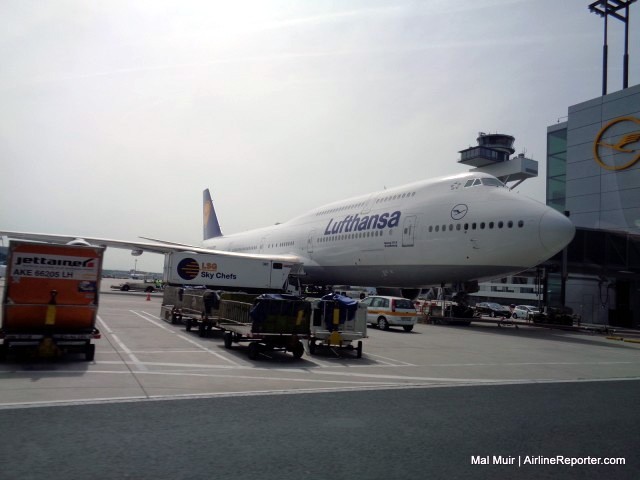
My ride to Newark — the first Boeing 747-8I (D-ABYA) to enter service commercially. Seen here from ground level!
I have been lucky enough to fly a few different airlines in first class. I am referring though to international first class here, not domestic ’œfirst class.’ An airline that I have been obsessed to fly in first class is Lufthansa.
My flight on Lufthansa would be two firsts for me: flying their first class and being a passenger on the updated Boeing 747-8 Intercontinental. Having one first is normally exciting enough as it is, but two? Yes… one could say that I was excited!
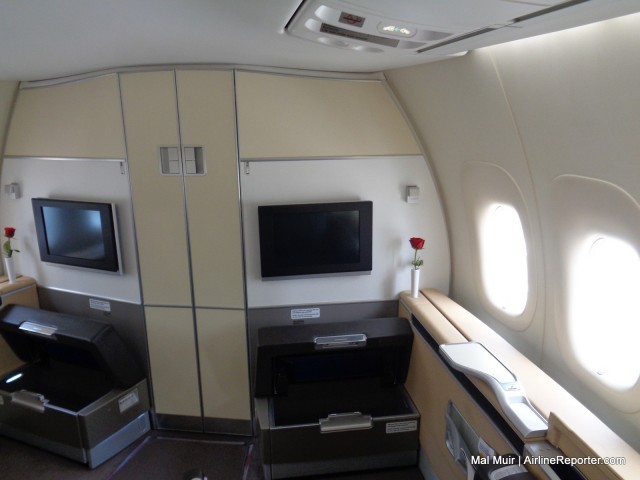
Lufthansa first class seats 1A & 1K, in the nose of a 747. Can’t get any far farther into the pointy end than this.
The benefit of departing Frankfurt with a first class ticket starts when one arrives at the airport. I was given access to their first class terminal, which was amazing. When it was time to board my flight, I was driven in a Mercedes Vito van that took me on a quick ride across the tarmac to my gate in the A/Z concourse.
Riding along at ground level and looking up at gate after gate of 747s is pretty special. When we pulled up to our gate, the very first 747-8I (D-ABYA) was looming above me. Being able to step out onto the ramp and snap a photo is nice. Being ushered all the way up to the aircraft by our driver is even better. Even though boarding was already underway when we arrived, our driver created a hole in the crowd and had us at the front in mere moments. Now THAT is service.
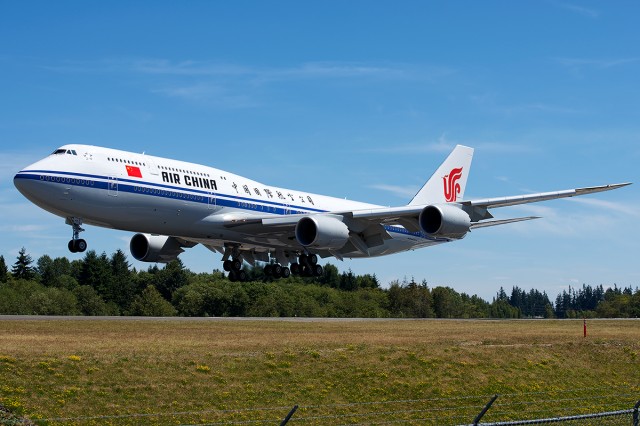
Air China’s first 747-8 completing its first flight – Photo: Bernie Leighton | AirlineReporter
Air China has taken delivery of their first 747-89L, making them the second operator of the 747-8 Intercontinental after Lufthansa.
Air China will operate the 747-8 on training flights from Beijing to Guangzhou’s Baiyun International Airport. The aircraft’s first international destination will be Frankfurt, with New York and Los Angeles both slated to gain service as more aircraft arrive.
Air China’s 747-8 is configured in four classes with 12 first class seats, 54 business class, 66 premium economy, and 233 economy seats. Economy class will offer between 32 and 33 inches of seat pitch, whilst Premium Economy will offer 38″. The aircraft will also feature onboard wifi.
The whole cabin was designed by famed Chinese designer Han Meilin. But it was odd that we didn’t get more information about the interior.
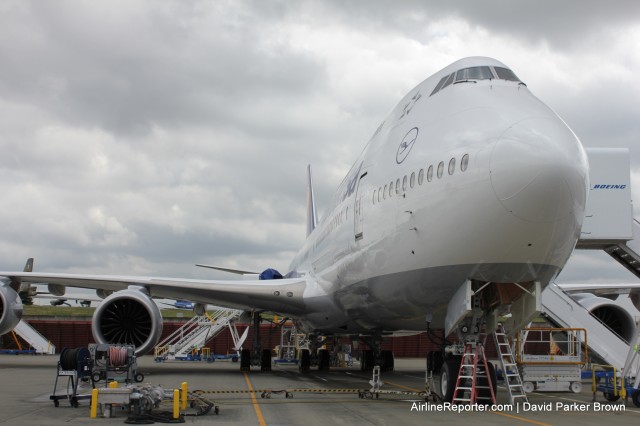
The 1,500th Boeing 747 (70th 747-8) sitting on the flight line at Paine Field
The 747 Jumbo Jet is an iconic aircraft. For years, it was the only double-deck commercial airliner and for many it is a favorite. From its first flight in 1969, the 747 has changed quite a bit. The newest iteration, the 747-8, might sport a similar shape to the original 747 or the 747-400, but it is quite a different beast (more than just LED lighting). This past weekend, the 1,500th 747 was delivered to Lufthansa Airlines. About a week earlier, Boeing took the opportunity to talk about their largest commercial airliner and its future relevance.
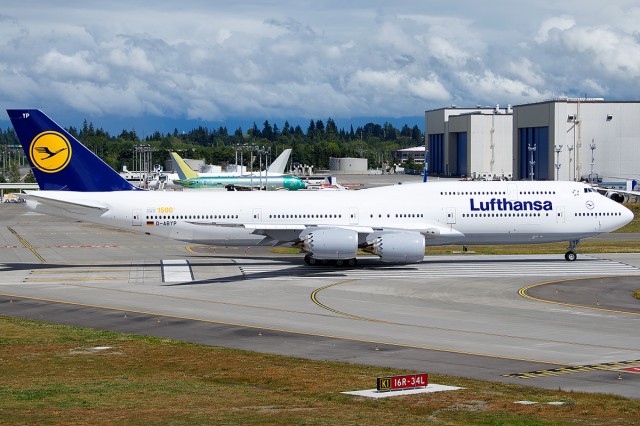
LN1500 lining up for take off – Photo: Bernie Leighton | AirlineReporter
I was invited to Boeing’s factory in Everett to sit down with Eric Lindblad, vice president and general manager of the 747 program, and we had a down-to-earth conversation about where the 747 has been, where it is today, and where Boeing is hoping it is going.
The big message that Lindblad wanted to get across is, “this is not your mother’s 747.” Not only is the 747-8I a very different aircraft than the 747-400, but the 70th 747-8 is much more efficient than the first one, and they plan to keep making it more efficient.
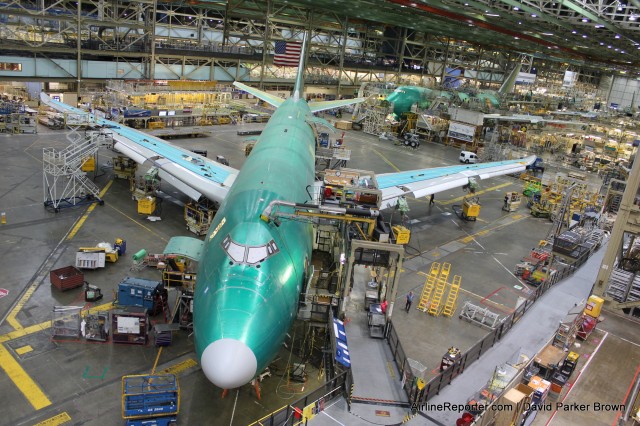
The money shot: 747 line inside the Boeing factory
Back in the 1960s Boeing made a big gamble. They decided to build the world’s largest airliner, the Boeing 747 Jumbo Jet. To build such a beast, they would need a large facility. After careful consideration, Boeing decided to build a large factory in Everett.
Since the first 747 rolled off the line in 1968, every other 747 has been built under the same roof. Even today, the 747-8 is built in the same factory.
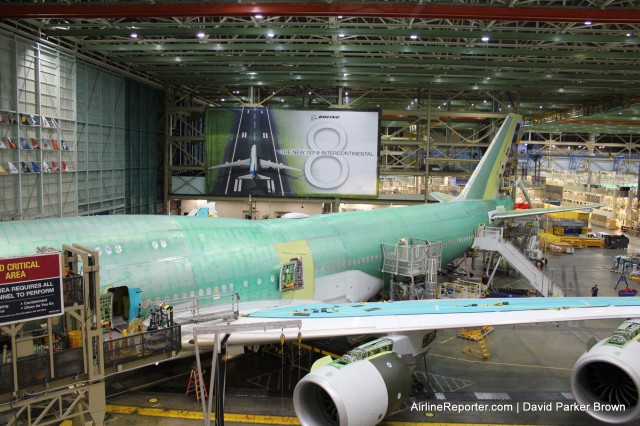
In case you didn’t know the aircraft type, there is a large sign on the wall.
Although Boeing offers public tours of the facility, they do not allow cameras. I was lucky enough to participate in a media event and take photos of the 747 line in the factory and I wanted to be able to share. Enjoy…
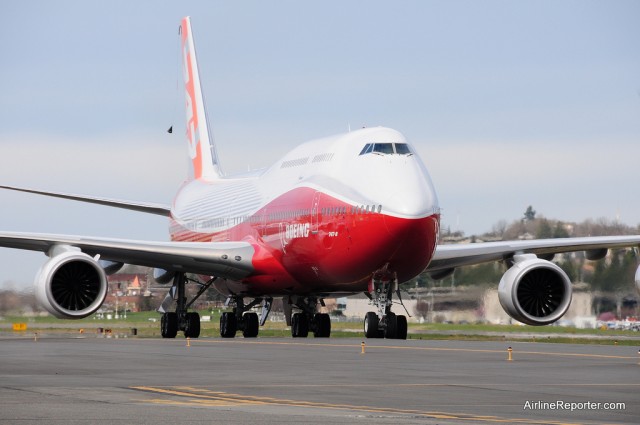
The first Boeing 747-8I. But how long will the model last?
There are few who can make a case against the Boeing 747 as the most majestic and beautiful airliner in the sky. I love the 747 (any variant) for its unique shape and instant recognition; you just won’t find folks lining up to tell you about the classic lines of the A380. Originally released in 1970, the Queen of the Skies has defined the term “jumbo jet” for multiple generations. But, despite the 747’s 40+ years as a long-haul mainstay for airlines around the world, is the future of the 747 and its latest variant, the 747-8, in jeopardy?
The Fiero Problem
The issue doesn’t seem to be that the 747 has gotten stale in its old age (in fact, Boeing’s latest version features new engines, a redesigned wing, a fuselage stretch, and advanced avionics; some might argue that Boeing spent WAY too much capital on a plane with so few orders). Rather, the problem seems to be that other planes have gotten so much better. This reminds me of that 80’s darling, the Pontiac Fiero, and its cool uncle, the Chevrolet Corvette.
GM and Pontiac built the Fiero from 1984-1988. A mid-engined, two-seater sports car with sharp (for the 80’s) looks, the Fiero did a lot of things well that the Corvette also was known for. Although not officially acknowledged by GM as a reason for ending the program, enthusiasts maintain that GM killed the Fiero because it was encroaching on the performance envelope of the ‘Vette, at lower acquisition and operating costs. Sound familiar? If you’ve ever flown on a Boeing 777, it should.







